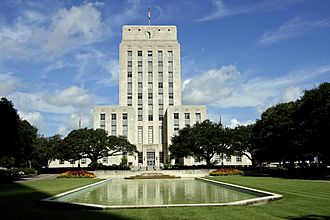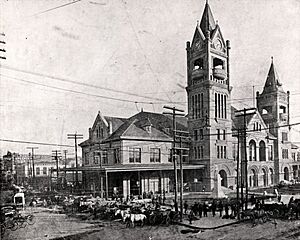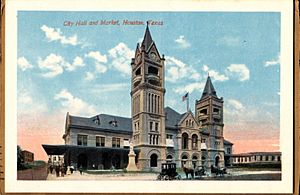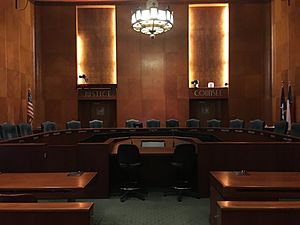Houston City Hall facts for kids
Quick facts for kids Houston City Hall |
|
|---|---|
 |
|
| General information | |
| Type | City hall |
| Architectural style | Art Deco, Modernistic |
| Address | 901 Bagby Street Houston, Texas 77002 |
| Coordinates | 29°45′37″N 95°22′10″W / 29.7602°N 95.3694°W |
| Construction started | March 7, 1938 |
| Completed | July 1939 |
| Cost | $1.67 million USD |
| Technical details | |
| Floor count | 17 |
| Design and construction | |
| Architect | Joseph Finger |
|
Houston City Hall
|
|
| Area | 3.1 acres (1.3 ha) |
| NRHP reference No. | 90001471 |
| Added to NRHP | September 18, 1990 |
The Houston City Hall building is where the City of Houston's government works. It's like the main office for the city! It was built between 1938 and 1939. You can find it on Bagby Street in Downtown Houston. The building looks a lot like other city halls built in the southwest U.S. around the same time. Next to City Hall, you'll find Tranquility Park and the Houston Public Library. This building has a simple but classic design.
Contents
History of Houston City Hall
For many years, from 1841 to 1939, Houston's city government was located at Old Market Square. The building there was damaged by fire twice, in the 1870s and again in 1901. Each time, it was rebuilt. Back then, City Hall was part of a busy market area.
However, by the 1920s, city leaders felt that the old location was no longer suitable. They wanted a new, dedicated space.
Building a New City Hall
In 1929, the city's planning group suggested creating a civic center around a downtown park called Herman Square. A civic center is a central area where important government buildings are located. But the Great Depression (a time of severe economic hardship) put these plans on hold.
When President Franklin Delano Roosevelt started the Works Progress Administration (WPA) program, it helped create jobs and build public projects. The city of Houston applied for WPA money to help pay for a new City Hall. The grant was approved, and construction began in March 1938. The building took 20 months to complete.
Architectural Vision and Statues
Joseph Finger designed the new City Hall in a "stripped classical" style. He wanted to put statues of John Kirby Allen and Augustus Chapman Allen (who founded Houston) on the front terrace. However, the city didn't have enough money for the statues, which would have cost $8,000. This was because the city was still recovering from the Great Depression.
Years later, in 2010, a group called the Daughters of the Republic of Texas (DRT) learned about the missing statues. Another group, the Oran M. Roberts Chapter 440, UDC, then raised the money to have the Allen Brothers statues made from bronze.
Honoring a Local Hero
On July 15, 2008, a famous surgeon named Dr. Michael E. Debakey was honored at Houston City Hall after he passed away. He was the first person from Houston to receive such an honor at the City Hall.
What Happens at City Hall
The Mayor of Houston and the City Controller have their offices inside the City Hall building. City Council Members, who help make decisions for the city, have their offices nearby in the City Hall Annex building.
The Houston City Council meets in the council chamber on Tuesdays at 1:30 PM and Wednesdays at 9:00 AM. Everyone is welcome to attend these meetings.
HTV Houston Television Studios
Starting in October 2013, a large area on the first floor of City Hall was updated. This 12,000-square-foot space was renovated for the studios of HTV Houston Television. HTV is the city's television channel. The renovations were finished on March 14, 2014.
Architectural Features
The architect who designed Houston City Hall was Joseph Finger. He was born in Austria but became a Texan architect. He designed many well-known buildings in the Houston area.
Exterior Design
The outside of the building has sculptures created by Herring Coe and Raoul Josset. The building is made from a special white Texas limestone. The front of City Hall faces Hermann Square, which you can reach by walking up paved terraces and stairs. The city hired Hare and Hare to design the park's rectangular reflecting pool and the plants around it, including lawns, shrubs, and oak trees.
Inside the Lobby
The design inside the lobby shows how government protects its people. Above the main entrances, you can see medallions (round designs) of "great lawgivers." These include important historical figures like Thomas Jefferson, Charlemagne, Julius Caesar, and Moses. Even the doorknobs inside have an old city seal on them!
The building's exterior is covered with Texas Cordova limestone. The main doors are made of a special type of aluminum. Inside, the lobby walls are covered with beautiful, lightly colored marble. The entrances to the Tax Department have detailed designs made from bronze, nickel, and silver. The areas around the elevators also have marble walls and trim.
Symbolic Sculptures
Above the lobby entrance, there is a stone sculpture. It shows two men trying to control a wild horse. This sculpture represents a community working together to form a government. The government helps to bring order to the world around them. The original plaster models for this sculpture and 27 other designs around the building were made by Beaumont artist Herring Coe and his co-designer Raoul Josset.
Hermann Square Park
The front of the City Hall building leads down to a small park called George and Martha Hermann Square. A large reflecting pool is the main feature of this park. This land was once owned by George H. Hermann, who also has Hermann Park in the Museum District named after him.
Hermann Square is simple but elegant. It is often used for different events like festivals, protests, and concerts. For bigger events, the reflecting pool can be covered with planks, and tents or kiosks are often set up.
- You can find many historical photographs about Houston and nearby communities at the University of Houston Digital Library.
Images for kids
See also
 In Spanish: Ayuntamiento de Houston para niños
In Spanish: Ayuntamiento de Houston para niños







